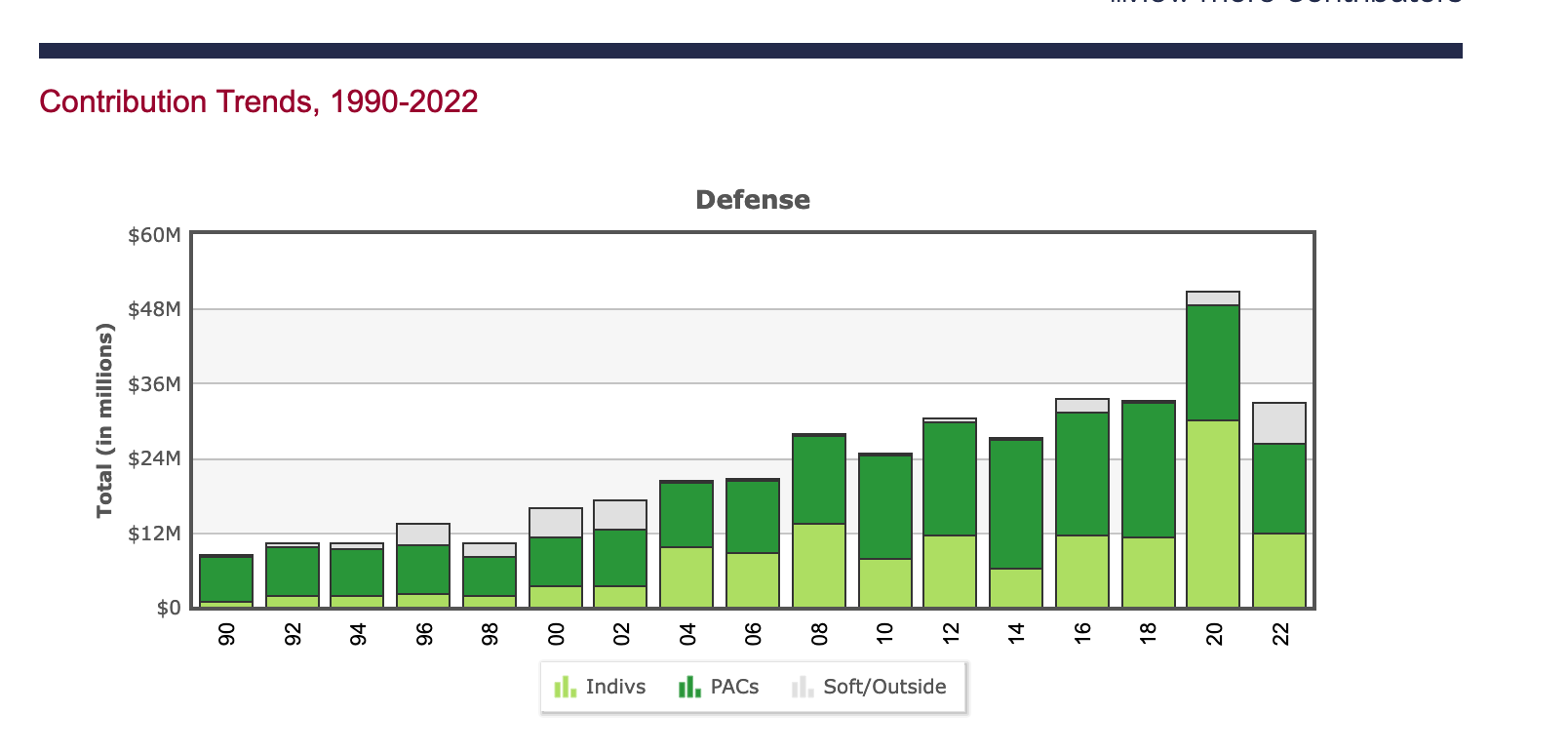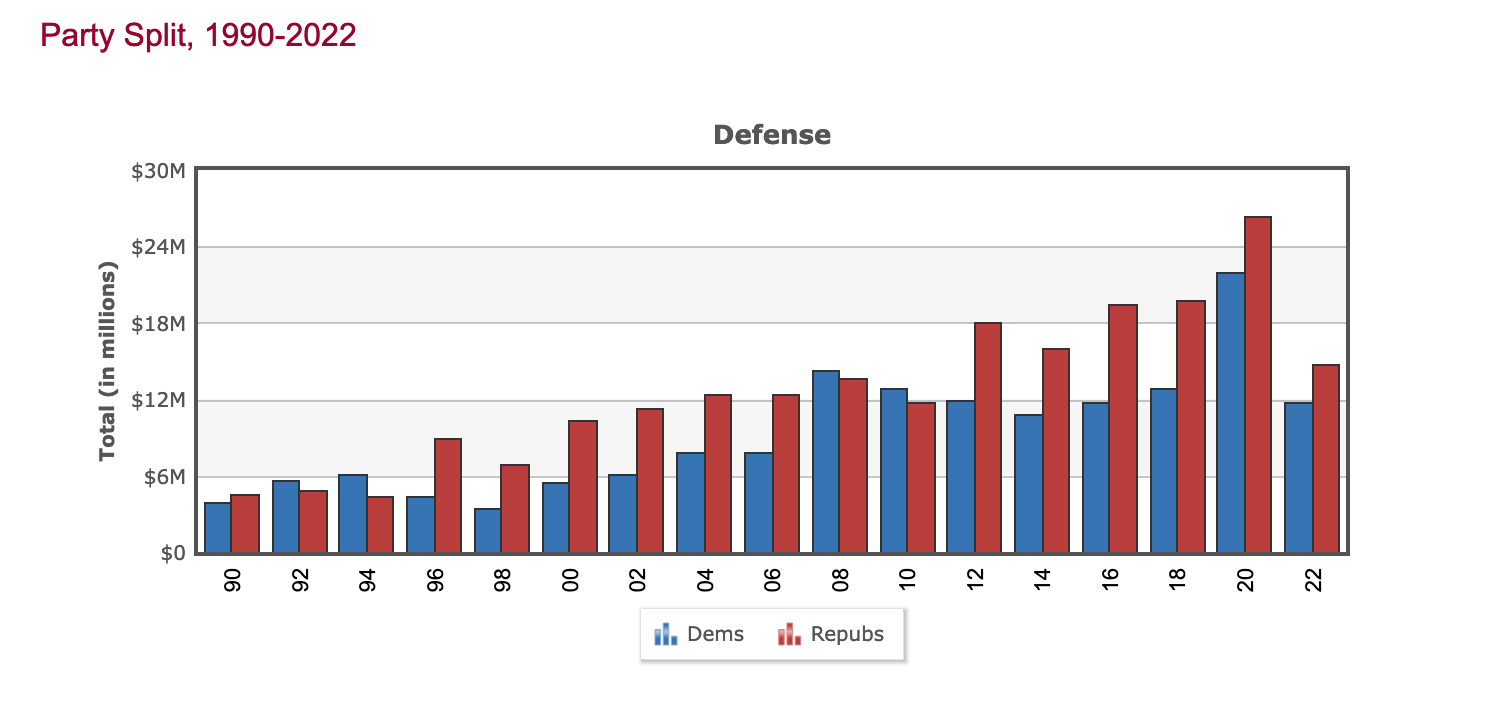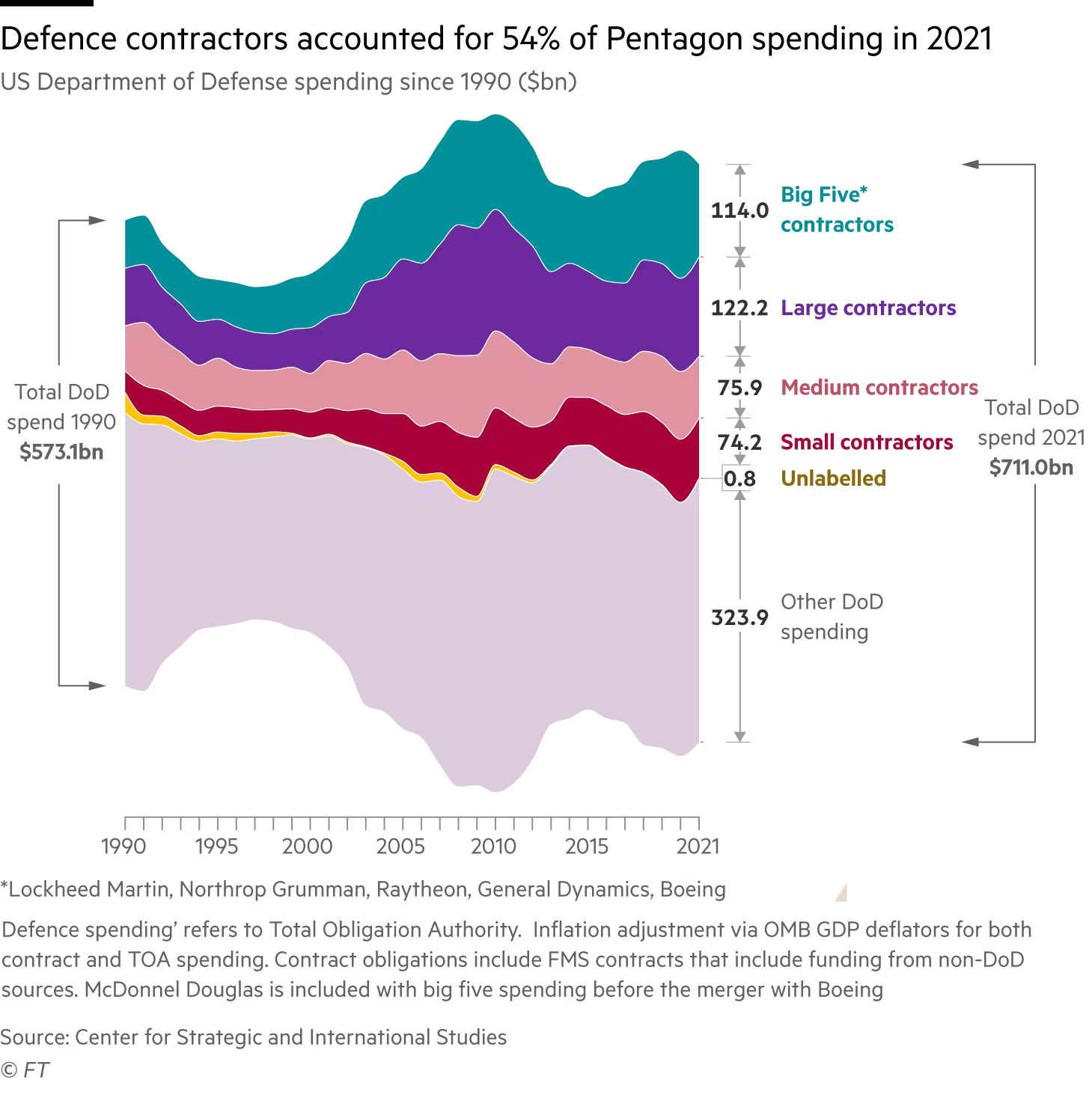 |
You Thought The Cold War Was Good For Weapons? You Ain't Seen Nothing Yet.
The Military Industrial Complex On Taxpayer-Funded Steroids
[Editorial note…sort of a repeat—I continue to be tied down with my new big global project on Just Transition for workers (You can subscribe to that newsletter at a special rate) so just having very little time to write here. I’ve enabled the paid subscription option so you can be part of keeping the posts coming! The rent must be paid!]
You might be in favor of an eye-popping, gargantuan military budget—or you might want the Pentagon to be chopped down to at least the level promised (and never realized) by a post-Cold War peacetime “dividend”.
But, at least, people need to know the facts. And be aware of what is happening.
To pay attention so we can have a rationale, open debate, and not simply stumble into an arms race that is ramping up every day.
This is not a secret: There is a massive—and, from my point of view, ominous and dangerous—expansion of the Pentagon. I’m re-upping this view from something I wrote a year ago:
The different pieces of a narrative are right in front of us, and it’s not hard to weave together a coherent big picture—but the traditional media has no interest in drilling down on or giving us a take on the big picture and, in fact, as we’ll see, the traditional media plays a central role in fueling the profits of the defense industry by promoting the “national security threats”.
The first observation: It would me a mistake to think the war in Ukraine is the only driver behind this. It’s quite useful, of course, to have a high-minded mission—in this case, saving Ukraine and Western “democracy”. I’m not going to spend a lot of time here, today, on the pro-con arguments over supporting Ukraine other than to note: one can simultaneously grasp what an utter pig Putin is (war-crime orders to relentlessly bomb civilian targets is, shall I say, quite Kissingeresque) AND roll ones eyes about the NATO call-to-arms in a self-described mission to preserve “democracy”.
The military build-up actually has its roots three decades ago and intensified long before the war in Ukraine. Essentially, since the fall of the Soviet Union, the defense industry has been groping around for the next “Evil Empire” to justify arms build-ups. Iraq didn’t quite fit the bill, either in 1991 or 2002 because, not withstanding the various bi-partisan propaganda and the thirst to control oil, Iraq was hardly a serious military threat (and, in fact, was an ally when it was convenient…).
The relentlessness of arms manufacturers can be seen through one lens: how it has bought of Congress, year after year, with political contributions. Again, not per se a surprise. But, relevant to the picture today.
Courtesy of Open Secrets, let’s look at two aspects of the legal corrupt business of lobbying. First, you can see a steadily rising flow of money dating back to 1990, and the particular spike around the 2020 presidential election—there was a real sense that, for military appropriations, it was crucial to be on the winning side:
And, when we think of “winning side”, there is no ideology other than dollars and cents. This is very much bi-partisan, with a slight but not overwhelming Republican bent; in fact, in certain periods when Democrats controlled the White House and the Congress (2008 and 2010) cycles, the money favored (slightly) Democrats:
You will note, now, in the nice fancy chart below courtesy of the Financial Times a few interesting trends (hence, I’m sorry to say, the insistence in incorrectly spelling “defence” because they are still smarting I guess over 1776. Whatever)
First, the dominance of the Big Five plus large defense contractors goes back way before the Ukraine War and is precisely a direct payoff for the money shelled out buying Congress—they certainly got their money’s worth.
Second, the majority of money spent for defense contractors—54 percent—in 2021 are funds Congress would have appropriated before the Ukraine war.
Third, pulling out the Big Five from the rest, you can see how five companies alone—Lockheed Martin, Northrop Grumman, Ratheon, General Dynamics and Boeing—rule the roost.
To be sure, the Ukraine war has relevance in the opportunity being seized by the Big Five. Let’s start with the stock market, again, courtesy of the Financial Times. Of note here are the share price of the Big Five Defence contractors (I kind of feel obligated to kowtow to the spelling, now and again, seeing as I’m using the FT’s charts):
Four of the five share prices of the “Big Five” rose after Russia’s invasion and did better than the S&P 500 since then; the share price of Boeing, whose commercial side business was taking hits partly because of the COVID-era airline industry issues, was floated up as well.
Now, let’s get a small taste of the almost daily drum beat of slavish promotion by media outlets of the need to expand the weapons industry.
A note first: generally speaking, “national security” or “Pentagon” reporters are some of the worst journalists. They function as virtually uncritical mouthpieces for the defense industry. They stand in front of the Pentagon seal and “report” the press releases from the Pentagon with nary a criticism. And they spew a stream of stories from their “national security sources”—it’s access journalism at its worst, with horrific consequences for the planet, because what is more valuable as a coin-of-the-realm “get” than a story from a “highly placed Pentagon source” or, even better, “a CIA source”. The worse part of this is: they believe it all.
Here you go:
Per the FT:
Lockheed would be willing to invest more in the expansion of capacity and purchasing materials with long lead times, says St John, “when we have a clear understanding of what the demand signal is going to be for some of these systems.”
There are currently no multi-year purchase contracts for munitions, unlike ships and aircraft, that “would incentivise [manufacturers] to make the investments to increase the capacity”, says Mark Cancian, senior adviser at the Center for Strategic and International Studies and former Pentagon budget strategist.
On the contrary, warns Northrop Grumman chief executive Kathy Warden, “inconsistent demand signal will result in production lines being shut down.”
In September, the Pentagon’s LaPlante said he was considering putting high-priority weapons and ammunition on two- to five-year contracts to replenish US stockpiles and supply Ukraine.
The government must put its money where its mouth is, says an industry source. Defence company executives would “be driven out of here by our shareholders” if they made decisions only based on Pentagon meetings and what they read in the news. “The way that the government needs to communicate [increased demand] is via contracts,” they say.
Or the push to rearm:
As a result of such efforts, says Mr Bush, production of Stinger shoulder-fired surface-to-air missiles will increase six-fold (from very low levels); that of Javelins (anti-tank weapons that helped to halt the Russians’ initial offensive) will double; ditto for HIMARS launchers, which have also proved their effectiveness in Ukraine, destroying arms dumps, command posts and barracks far behind the front lines.
Output of 155mm shells will triple and possibly increase six-fold, to over 1m a year, as the Pentagon sets up another production line in Texas and issues contracts to a firm in Canada. But much of the extra capacity will not be available until 2024 or even 2028. “I think the American economy is capable, and knows how to do this,” declares Mr Bush. “It’s simply a matter of time. It’s not a new thing. Industrial mobilisation in world war two and the Korean war also took time.”
A similar process is under way in Europe. Armin Papperger, boss of Germany’s Rheinmetall, says his firm can quickly lift production from 70,000 to 450,000 shells a year or more, having recently agreed to buy Expal Systems, a Spanish ammunition producer. Rheinmetall is also setting up a new munitions plant in Hungary. CSG, a Czech arms manufacturer that produced 100,000 shells last year, is hoping to boost its output to 150,000 this year. A Norwegian firm, Nammo, could also increase production. Former Warsaw Pact countries are even toying with reopening factories to make 152mm munitions, so Ukraine can keep using its Soviet artillery.
The sky is falling! From across the pond, it’s an explosives shortage:
Europe’s push to make arms for Ukraine has been hobbled by a shortage of explosives, which industry insiders fear will delay efforts to boost shell production by as much as three years. Scarce supplies of gunpowder, plastic explosives and TNT have left industry unable to rapidly meet expected EU orders for Ukraine, regardless of how much money is thrown at the problem, according to officials and producers. The supply chain constraints underline how Russia’s invasion of Ukraine has badly exposed Europe’s inadequate arms stocks and weak domestic production capacity, run down by decades of under-investment. “The fundamental problem is that the European defence industry is not in good shape for large-scale war production,” said one German official.
Here, you get shells are needed!
More than a year after Russia’s full-scale invasion of Ukraine, U.S. plans to increase production of key munitions have fallen short due to shortages of chips, machinery and skilled workers.
Arms makers have added factory shifts, ordered new equipment and streamlined supply chains to boost output of Javelin antitank missiles, artillery shells, guided rockets and much more, which Ukrainian forces are firing by the thousands at the Russian invaders.
Years of stop-start Pentagon funding for munitions led companies to close production lines or quit the industry, while output of many components and raw materials moved overseas. Defense Department chiefs estimate the decline will take five or six years to reverse.
“We want to get the fragility out of the system, so if this ever happens again, it’s six months instead of three years to get a meaningful improvement in capacity,” said Jim Taiclet, chief executive officer of Lockheed Martin Corp.
And:
“We have more than doubled the capacity with the investments we’ve laid in or plan to make,” Northrop Grumman Corp. CEO Kathy Warden said this week. “For the government to go even further than that, we are suggesting that we can support that, but would look for government funding to complement it.”
To justify all this, you can’t just rely on shallow journalists. The defense industry needs what policymakers would view as “independent” intellectual justification. So, it turns to—and helps fund—the consistent voices for a global arms race. We get, for example, “Empty Bins in a Wartime Environment: The Challenge to the U.S. Defense Industrial Base” from the reliable voice for a global superpower, the Center for Strategic and International Studies:
The U.S. defense industrial base is not adequately prepared for the international security environment that now exists. In a major regional conflict—such as a war with China in the Taiwan Strait—the U.S. use of munitions would likely exceed the current stockpiles of the U.S. Department of Defense. According to the results of a series of CSIS war games, the United States would likely run out of some munitions—such as long-range, precision-guided munitions—in less than one week in a Taiwan Strait conflict. The war in Ukraine has also exposed serious deficiencies in the U.S. defense industrial base and serves as a stark reminder that a protracted conflict is likely to be an industrial war that requires a defense industry able to manufacture enough munitions, weapons systems, and matériel to replace depleted stockpiles.
As timelines for a possible conflict in Asia shrink, the goal should be to support the production capacity required to enable the United States and its allies and partners to deter and, if deterrence fails, fight and win at least one major theater war—if not two. “Just in time” and lean manufacturing operations must be balanced with carrying added capacity. The U.S. Department of Defense, in coordination with Congress, should develop a plan now that involves taking steps to streamline and improve production, acquisitions, replenishment, Foreign Military Sales, ITAR, and other policies and procedures. A revitalization of the defense industrial base will not happen overnight for the United States or its allies and partners. It is time to prepare for the era of competition that now exists.
I hone in on this particular drivel above—you can find reams of similar papers and reports, all written with a very somber-sounding “expertise”—because it allows us to pivot back away from the Ukraine war.
Because, as I noted two years ago in this newsletter, there has been a much broader “Red Scare” drum beat that has taken hold throughout the political-media-business elites. Here is my observation from two years ago:
In the way the Soviet Union justified the expenditure of trillions of dollars over almost half a century, China is the new “golden calf” for the defense industry. To be clear, you can hold on to two thoughts at the same time: China is an extremely repressive, authoritarian regime AND that this new “Red Scare” rubbish has nothing to do with some great political ideological communism-versus-capitalism battle since China has been a favorite industrial production “come-use-our-slave-labor” destination for every company from Wal-Mart to Nike to Ivanka Trump’s clothing line.
It’s all about the Benjamins.
That helps us see how the lavishing of tax payer money on the war machine also bleeds very much into the “industrial” arena, with the broader new “Red Scare” used as a justification. Specifically, as an example, the recent $52 billion handout to the semiconductor industry. This industry could not exist without a military component (aside: people made fun of Al Gore when he said he had helped invent the Internet but, in fact, it was during his time as vice president that the Defense Advanced Research Projects Agency, a research and development agency of the United States Department of Defense, took major steps in furthering the infrastructure called ARPANET the first packet-switched computer network). Missiles and virtually every piece of military hardware run on microchips.
But, the leading argument for handing $52 billion to a very profitable industry had to be gussied up with some greater national security component so, presto, the “Red Scare”—which also helped siphon $2 billion in a direct allocation to the Pentagon for microelectronics projects.
The next frontier being engaged in this arena is, and will be, artificial intelligence.
I’ll wrap this up here. Sound the alarm.
You're currently a free subscriber to Working Life Newsletter. For the full experience, upgrade your subscription.




